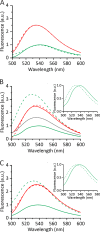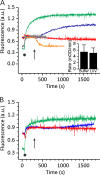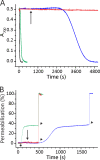Membrane damage by an α-helical pore-forming protein, Equinatoxin II, proceeds through a succession of ordered steps
- PMID: 23803608
- PMCID: PMC3745318
- DOI: 10.1074/jbc.M113.481572
Membrane damage by an α-helical pore-forming protein, Equinatoxin II, proceeds through a succession of ordered steps
Abstract
Actinoporin equinatoxin II (EqtII) is an archetypal example of α-helical pore-forming toxins that porate cellular membranes by the use of α-helices. Previous studies proposed several steps in the pore formation: binding of monomeric protein onto the membrane, followed by oligomerization and insertion of the N-terminal α-helix into the lipid bilayer. We studied these separate steps with an EqtII triple cysteine mutant. The mutant was engineered to monitor the insertion of the N terminus into the lipid bilayer by labeling Cys-18 with a fluorescence probe and at the same time to control the flexibility of the N-terminal region by the disulfide bond formed between cysteines introduced at positions 8 and 69. The insertion of the N terminus into the membrane proceeded shortly after the toxin binding and was followed by oligomerization. The oxidized, non-lytic, form of the mutant was still able to bind to membranes and oligomerize at the same level as the wild-type or the reduced form. However, the kinetics of the N-terminal helix insertion, the release of calcein from erythrocyte ghosts, and hemolysis of erythrocytes was much slower when membrane-bound oxidized mutant was reduced by the addition of the reductant. Results show that the N-terminal region needs to be inserted in the lipid membrane before the oligomerization into the final pore and imply that there is no need for a stable prepore formation. This is different from β-pore-forming toxins that often form β-barrel pores via a stable prepore complex.
Keywords: Actinoporin; Equinatoxin; Erythrocyte; Fluorescence; Kinetics; Membrane; Pore Forming; Toxins.
Figures







Similar articles
-
Neutron reflection study of the interaction of the eukaryotic pore-forming actinoporin equinatoxin II with lipid membranes reveals intermediate states in pore formation.Biochim Biophys Acta. 2016 Apr;1858(4):640-52. doi: 10.1016/j.bbamem.2015.12.019. Epub 2015 Dec 17. Biochim Biophys Acta. 2016. PMID: 26706098
-
Structure and activity of the N-terminal region of the eukaryotic cytolysin equinatoxin II.Biochemistry. 2006 Feb 14;45(6):1818-28. doi: 10.1021/bi052166o. Biochemistry. 2006. PMID: 16460028
-
Pore formation by equinatoxin, a eukaryotic pore-forming toxin, requires a flexible N-terminal region and a stable beta-sandwich.J Biol Chem. 2004 Nov 5;279(45):46509-17. doi: 10.1074/jbc.M406193200. Epub 2004 Aug 20. J Biol Chem. 2004. PMID: 15322132
-
Sticholysins, two pore-forming toxins produced by the Caribbean Sea anemone Stichodactyla helianthus: their interaction with membranes.Toxicon. 2009 Dec 15;54(8):1135-47. doi: 10.1016/j.toxicon.2009.02.022. Epub 2009 Mar 4. Toxicon. 2009. PMID: 19268489 Review.
-
Molecular mechanism of sphingomyelin-specific membrane binding and pore formation by actinoporins.Adv Exp Med Biol. 2010;677:106-15. Adv Exp Med Biol. 2010. PMID: 20687484 Review.
Cited by
-
A non-toxic equinatoxin-II reveals the dynamics and distribution of sphingomyelin in the cytosolic leaflet of the plasma membrane.Sci Rep. 2024 Jul 23;14(1):16872. doi: 10.1038/s41598-024-67803-2. Sci Rep. 2024. PMID: 39043900 Free PMC article.
-
Dissecting the mechanism of action of actinoporins. Role of the N-terminal amphipathic α-helix in membrane binding and pore activity of sticholysins I and II.PLoS One. 2018 Aug 30;13(8):e0202981. doi: 10.1371/journal.pone.0202981. eCollection 2018. PLoS One. 2018. PMID: 30161192 Free PMC article.
-
Sticholysin, Sphingomyelin, and Cholesterol: A Closer Look at a Tripartite Interaction.Biophys J. 2019 Jun 18;116(12):2253-2265. doi: 10.1016/j.bpj.2019.05.010. Epub 2019 May 16. Biophys J. 2019. PMID: 31146924 Free PMC article.
-
Panorama of the Intracellular Molecular Concert Orchestrated by Actinoporins, Pore-Forming Toxins from Sea Anemones.Toxins (Basel). 2021 Aug 13;13(8):567. doi: 10.3390/toxins13080567. Toxins (Basel). 2021. PMID: 34437438 Free PMC article. Review.
-
The Important Role of Membrane Fluidity on the Lytic Mechanism of the α-Pore-Forming Toxin Sticholysin I.Toxins (Basel). 2023 Jan 16;15(1):80. doi: 10.3390/toxins15010080. Toxins (Basel). 2023. PMID: 36668899 Free PMC article.
References
-
- Parker M. W., Feil S. C. (2005) Pore-forming protein toxins. From structure to function. Prog. Biophys. Mol. Biol. 88, 91–142 - PubMed
-
- Anderluh G., Lakey J. H. (2008) Disparate proteins use similar architectures to damage membranes. Trends Biochem. Sci. 33, 482–490 - PubMed
-
- Dalla Serra M., Tejuca Martinez M. (2011) Pore-forming toxins. eLS, DOI: 10.1002/9780470015902.a0002655.pub2 - DOI
-
- Heuck A. P., Tweten R. K., Johnson A. E. (2001) β-barrel pore-forming toxins. Intriguing dimorphic proteins. Biochemistry 40, 9065–9073 - PubMed
-
- Mueller M., Grauschopf U., Maier T., Glockshuber R., Ban N. (2009) The structure of a cytolytic α-helical toxin pore reveals its assembly mechanism. Nature 459, 726–730 - PubMed
Publication types
MeSH terms
Substances
LinkOut - more resources
Full Text Sources
Other Literature Sources

